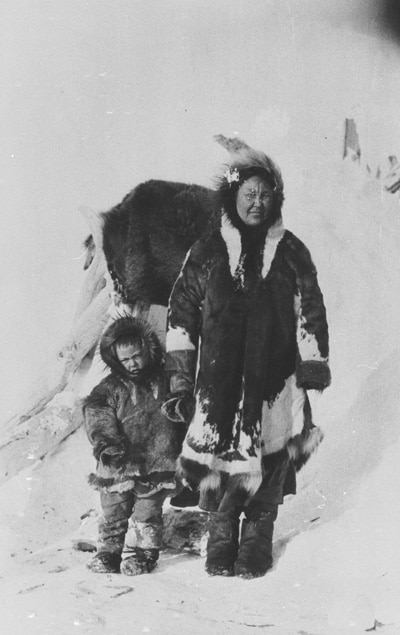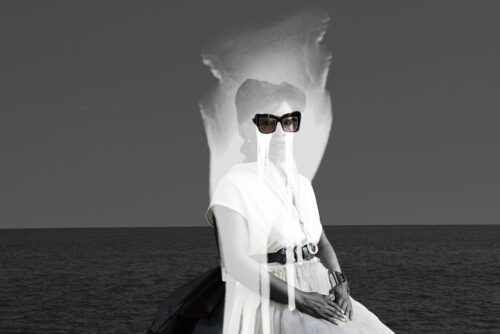Stefansson: The Inuit Connection
Stefansson’s first expedition (1906-1907) was brief. He was determined, however, to return to the Arctic for a second expedition (1908-1912). In the Arctic, guests from the south usually placed themselves higher up on the social ladder than the Inuit, and Stefansson was no exception. About three months after he left “civilization” for his second expedition, Stefansson encountered and hired Fanny Pannigabluk who traveled with him for most of the expedition. Their son Alex Stefansson was born in the middle of the expedition, on 10 March 1910. During Stefansson’s third expedition (1913-1918) with the fatal sinking of his ship The Karluk, he somewhat unexpectedly renewed his relationship with his wife and child; Pannigabluk became again a member of the Stefansson party. Stefansson had not seen his son for a couple of years or so. Now he taught him to read and write and Alex quickly became bilingual.
Apparently it was during this expedition that the first photographs were taken of Stefansson’s Inuit family. The oldest picture of Pannigabluk and Alex that has been preserved is from 1913, around the time when Stefansson renewed his relationship with his family. Pannigabluk looks rather shy, avoiding the gaze of the photographer, G.H. Wilkins (see Photo 2), perhaps observing Inuit manners requiring that a woman look down, not directly at another adult, especially a man.


Judging from Stefansson’s field diaries Pannigabluk had a much more important role than Stefansson’s publications indicate. Her name appears quite often in Stefansson’s diaries. Pannigabluk was not just a seamstress who made fine clothes from animal skins, she would also act as interpreter and narrator. In effect, she was Stefansson’s closest ethnographic collaborator—his “key informant”. Like most of his contemporaries, Stefansson was unable to acknowledge the intellectual role of his indigenous collaborators, in particular women. While Stefansson praises the qualities and contributions of some of his indigenous male collaborators, including Roxy Memogana and Natkusiak (Billy Banksland), he rarely mentions his female sources.
Stefansson seems to have prepared his son for a trip to Seattle or Vancouver at the end of the last expedition and then to the east coast of the United States, where Alex would presumably adapt to the world of whites. If this was the case, Pannigabluk who was almost fifty at this point and with two relationships behind her must have refused to let her son go. After all, he was her only security in old age. Stefansson wrote in his diary during the third expedition (22 Desember 1916) that several years before he met Pannigabluk she had twins, both boys, with her late husband Alahuk. One of the boys was left to die on the ice, according to the demands of the husband and “all the others”, probably for fear of famine. The other died at the age of ten. Perhaps this helps to explain why Pannigabluk would not accept losing Alex.
Whatever Stefansson thought of Pannigabluk, their Inuit companions regarded them as husband and wife. Their conjugal relationship is underlined in church records from Herschel Island marked as “Eskimos: Baptisms, marriages, and funerals”. On 15 August 1915, in the middle of Stefansson’s third expedition, Reverend Whittaker baptized Pannigabluk, “Stefansson’s wife”, and “their five-year-old son (Alex) Alik Alahuk”. Stefansson never returned to his Inuit family, but some evidence indicates that he paid their bills at the Hudson Bay store in Aklavik long after he left. Significantly, perhaps, Stefansson did not marry until Pannigabluk had died, the same year in fact, more than two decades after he left the field.



